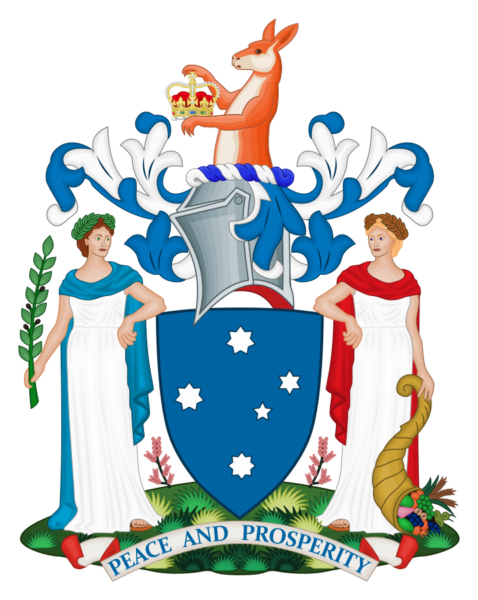 The Victorian Coat of Arms was granted by King George V by Royal Warrant of 6 June 1910. On 28 March 1973, Queen Elizabeth II signed a Royal Warrant which added Victoria’s floral emblem, the Pink Heath, to Victoria’s Coat of Arms. The Victorian Coat of Arms is used by State Government bodies, but not the Supreme or County Courts.
The Victorian Coat of Arms was granted by King George V by Royal Warrant of 6 June 1910. On 28 March 1973, Queen Elizabeth II signed a Royal Warrant which added Victoria’s floral emblem, the Pink Heath, to Victoria’s Coat of Arms. The Victorian Coat of Arms is used by State Government bodies, but not the Supreme or County Courts.
The blazon or technical description was as follows:
* Arms: Azure, five Stars Argent representing the Constellation of the Southern Cross.
* Crest: On a Wreath of the Colours, Argent and Azure, a demi-Kangaroo proper holding in the paws an Imperial Crown Or.
* Supporters: Dexter, a Female Figure (representing Peace) proper vested Argent cloaked Azure wreathed round the temples with a Chaplet and holding in the exterior hand a branch of Olive also proper; and Sinister, a like figure (representing Prosperity) vested Argent cloaked Gules wreathed round the temples with a Chaplet of Corn and supporting with the exterior hand a Cornucopia proper.
* Motto: Peace and Prosperity
In other words, the Shield was blue with five silver stars thereof arranged so as to represent the Crux Australis. Although now met with frequently in Australian heraldry, this is an early example of this particular heraldic charge.
Rising from a Crest Wreath comprising silver and blue alternate twists (the official colours of the State), the Crest is made up of the upper part of a kangaroo shown in it’s natural colours. The beast supports with it’s claws a Royal Crown, in its Imperial interpretation, which is shown gold throughout.
The Supporters, so called from their function of ‘supporting’ the Shield on either side, are human figures. They are both classical in conception. That to the viewer’s left wears a laurel wreath crown and representing, as she does, ‘Peace’ carries a sprig of olive in her hand. The corresponding figure on the viewer’s right is a personification of ‘Prosperity’. She has upon her head a circlet of golden cereal, and with her exterior hand supports a Cornucopia, symbolic of the result of peace.
The image which inspired the Supporters is again expressed in the motto: Peace and Prosperity – interestingly enough, the first motto to be in English among the Arms of Public Authority in the country.
There were no changes for the next half century. However, in 1958 the Pink Heath (Epacris impressa Labill.) was formally proclaimed as the floral emblem of Victoria. This in turn led to a desire that it be included somewhere in the Armorial Ensigns of the State. To this end, correspondence was entered into with Garter King of Arms. The obvious solution was to have the plant shown growing from a grassy mound which would in turn supply a firm base for the two Supporters. Such a mound is called a Compartment in heraldry.
Accordingly, on the 28th March, 1973 Queen Elizabeth II signed a further Royal Warrant which added the desired component out of which the State flower was shown growing. While the remainder of the Armorial Bearings remained essentially the same as in the 1910 Royal Warrant, the opportunity was taken to reinterpret certain of the elements. For example, the Crest Kangaroo now holds a St. Edward’s Crown. Yet again, the interpretation of the female Supporters was more in accord with the current ‘conception of Australian womanhood’ to quote the suggestion put forward at the time by the Premier’s Department.
Victoria’s Bird Emblem
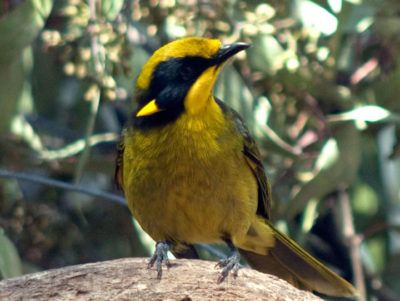 The Helmeted Honeyeater Lichenostomus melanops cassidix (Gould, 1867) is the larger and more brilliantly coloured race of the Yellow-tufted Honeyeater. Previously regarded as a separate species , recent studies indicate an area of interbreeding between it and the Yellow-tufted Honeyeater.
The Helmeted Honeyeater Lichenostomus melanops cassidix (Gould, 1867) is the larger and more brilliantly coloured race of the Yellow-tufted Honeyeater. Previously regarded as a separate species , recent studies indicate an area of interbreeding between it and the Yellow-tufted Honeyeater.
Pure populations of this attractive honeyeater are now restricted to a small area on Woori Yallock Creek near Yellingbo on the outskirts of Melbourne. The Yellingbo State Wildlife Reserve was established to protect the few remaining colonies numbering some 100-150 birds. The Helmeted Honeyeater is particularly vulnerable to habitat disturbances as it requires a combination of manna and swamp gums, with tea-trees and shrubby bushes alongside grass-lined watercourses.
The birds are about 20cm in total length and the sexes are similar. The upperparts of the body are olive-grey with the outer wing and tail feathers greenish-yellow. Underparts are yellowish-green with dark streaks. The sides of the head are glossy black with golden ear-tufts and a yellow throat. Both crown and fore-head are golden yellow with the latter displaying plushlike feathers projecting slightly over the base of the bill and forming a distinctive helmet.
Proclaimed by the Governor in Council on 10th March, 1971.
Victoria Animal Emblem
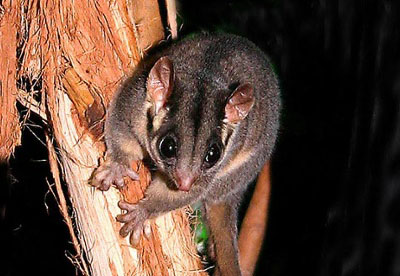 As far as is known, Leadbeater’s possum Gymnobelideus leadbeateri McCoy lives only in Victoria. It is confined to the mountain ash forests of the central highlands, from Healesville and Marysville to Mt Baw Baw. Photo Coutesy: leadbeaters.org.au
As far as is known, Leadbeater’s possum Gymnobelideus leadbeateri McCoy lives only in Victoria. It is confined to the mountain ash forests of the central highlands, from Healesville and Marysville to Mt Baw Baw. Photo Coutesy: leadbeaters.org.au
Even in the days of the early naturalists in Victoria, this possum was regarded as one of the rarer members of our fauna. McCoy’s original specimens were collected in 1867 north of the Wonthaggi area of West Gippsland, and a few more were found up to 1909, when the possum was thought to be extinct. It was a great surprise to science when the species was rediscovered near Marysville in 1961.
Whilst it is scattered over a large area, individual possums are usually found in pockets of relatively high density, particularly in old trees with hollows which provide sites for nesting.
The well being of this species seems to be closely associated with the botanical succession within the mountain ash (Eucalyptus regnans) forests. It is important that adequate provision be made for it amongst the diverse demands on our hardwood forests.
The length of Leadbeater’s Possum is about 40cm from nose to tail tip. About half of the animal is taken up by the tail. Soft, dense fur covers the body, becoming progressively longer on the distinctively club-shaped tail. The colour of the animal is a dark greyish-brown with whitish under-parts. The face is quite beautifully marked.
Unlike some of the possums close to its size, it does not have any gliding membrane.. It is a nimble species, which jumps around from branch to branch. It feeds on insects living on the foliage and under the bark of eucalypts, plant exudates, honey-dew from insects and some sap and gum. The Leadbeater’s Possum breeds from February to November producing 1-2 young in a litter. The future of this species lies heavily in the hands of those governing management processes in it’s native habitat.
Proclaimed 2nd March, 1971.
Government Gazette No. 20, dated 10th March, 1971.
Victoria Floral Emblem
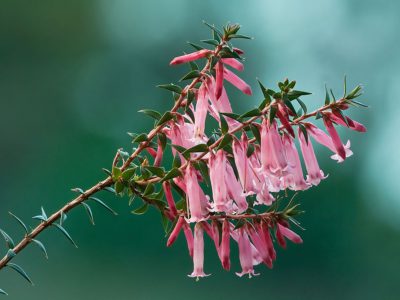 The Common (Pink) Heath, Epacris impresa Labill., was found in Tasmania by the French explorer Labillardière in 1793, and was described by him in 1805 following his return to France.
The Common (Pink) Heath, Epacris impresa Labill., was found in Tasmania by the French explorer Labillardière in 1793, and was described by him in 1805 following his return to France.
It is a slender shrub, usually 0.2 to 1 metre high, with a few erect branches and with flowers ranging in colour from white through pink to red. The spreading leaves which are 8 to 15 mm long, are stiff, narrow and tapered to a sharp point. The showy bell-like flowers are found on the upper parts of the branches. Frequently all flowers point in the same direction.
The name impressa refers to the indentations at the base of the flower-tube. This is a feature not found in any other Epacris.
The Common (Pink) Heath is frost-hardy and normally flowers through winter and spring, although some flowers have been recorded as early as March.
Introduced into cultivation in Britain about 1830, and cultivated in the United States, these attractive flowering plants make a colourful display in many of Victoria’s winter gardens where they may also attract their normal bird pollinating vector, the Eastern Spinebill which hovers in front of the flowers and is well adapted to their pollination.
Proclaimed 11th November, 1958.
Government Gazette No. 98, dated 12th November.
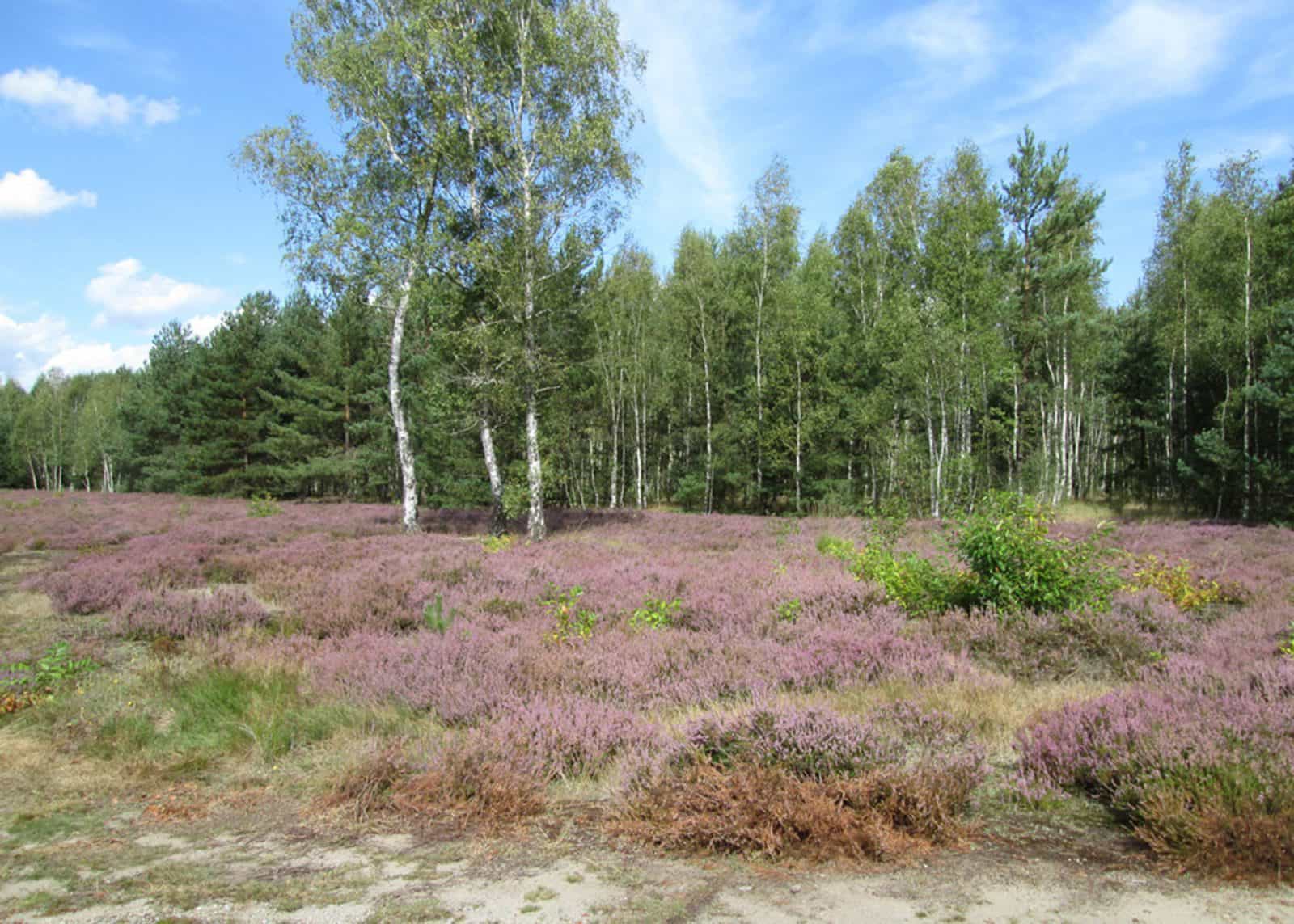
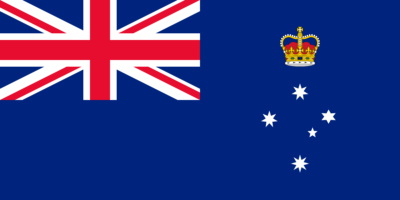 A despatch from the Secretary of State for the Colonies, in December, 1865, required that all colonial vessels of war wear a Blue Ensign with the seal or badge of the Colony in the fly and a Blue Pennant. On the 4th February, 1870, a proclamation by the Governor directed that the badge of the Colony of Victoria be of the following design – “five white stars, representing the constellation of the Southern Cross.”
A despatch from the Secretary of State for the Colonies, in December, 1865, required that all colonial vessels of war wear a Blue Ensign with the seal or badge of the Colony in the fly and a Blue Pennant. On the 4th February, 1870, a proclamation by the Governor directed that the badge of the Colony of Victoria be of the following design – “five white stars, representing the constellation of the Southern Cross.” The Victorian Coat of Arms was granted by King George V by Royal Warrant of 6 June 1910. On 28 March 1973, Queen Elizabeth II signed a Royal Warrant which added Victoria’s floral emblem, the Pink Heath, to Victoria’s Coat of Arms. The Victorian Coat of Arms is used by State Government bodies, but not the Supreme or County Courts.
The Victorian Coat of Arms was granted by King George V by Royal Warrant of 6 June 1910. On 28 March 1973, Queen Elizabeth II signed a Royal Warrant which added Victoria’s floral emblem, the Pink Heath, to Victoria’s Coat of Arms. The Victorian Coat of Arms is used by State Government bodies, but not the Supreme or County Courts. The Helmeted Honeyeater Lichenostomus melanops cassidix (Gould, 1867) is the larger and more brilliantly coloured race of the Yellow-tufted Honeyeater. Previously regarded as a separate species , recent studies indicate an area of interbreeding between it and the Yellow-tufted Honeyeater.
The Helmeted Honeyeater Lichenostomus melanops cassidix (Gould, 1867) is the larger and more brilliantly coloured race of the Yellow-tufted Honeyeater. Previously regarded as a separate species , recent studies indicate an area of interbreeding between it and the Yellow-tufted Honeyeater. As far as is known, Leadbeater’s possum Gymnobelideus leadbeateri McCoy lives only in Victoria. It is confined to the mountain ash forests of the central highlands, from Healesville and Marysville to Mt Baw Baw. Photo Coutesy:
As far as is known, Leadbeater’s possum Gymnobelideus leadbeateri McCoy lives only in Victoria. It is confined to the mountain ash forests of the central highlands, from Healesville and Marysville to Mt Baw Baw. Photo Coutesy:  The Common (Pink) Heath, Epacris impresa Labill., was found in Tasmania by the French explorer Labillardière in 1793, and was described by him in 1805 following his return to France.
The Common (Pink) Heath, Epacris impresa Labill., was found in Tasmania by the French explorer Labillardière in 1793, and was described by him in 1805 following his return to France.